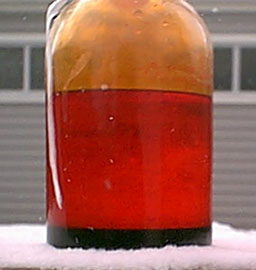"Causes irritation to the gastrointestinal tract. Symptoms may include nausea, vomiting and diarrhea. May cause abdominal pain, reduced urinary output, low blood pressure, methemoglobinemia, convulsions, liver and kidney damage, and coma. Cyanosis may occur as a later symptom. Death may occur from renal failure, within 1 to 2 weeks. Estimated lethal dose is 4 grams."
Sounds like something really great to have in food products.
 The MSDS must be
exagerating...
The MSDS must be
exagerating...Source:
http://www.jtbaker.com/msds/englishhtml/p5576.htm





 So, I've concluded that a slight excess of Br- in solution will destroy some
Br2 and that an excess of Cl2 will also destroy it!
So, I've concluded that a slight excess of Br- in solution will destroy some
Br2 and that an excess of Cl2 will also destroy it!  Although I'm putting
a good deal of ice into it. Anyway, if I finally do get anything from this batch, I'll store it in a glass vial. Unfortunately, the underside of
the cap is made of some junk which will no doubt liquefy on contact with the bromine just like it did with iodine. Does anyone have any ideas about
insulating it with something inert? PE & PP probably won’t work and my PTFE tape is completely permeable to corrosive vapors.
Although I'm putting
a good deal of ice into it. Anyway, if I finally do get anything from this batch, I'll store it in a glass vial. Unfortunately, the underside of
the cap is made of some junk which will no doubt liquefy on contact with the bromine just like it did with iodine. Does anyone have any ideas about
insulating it with something inert? PE & PP probably won’t work and my PTFE tape is completely permeable to corrosive vapors. works if you add the correct amount. The flame retardant doesn't disturb the reaction.
works if you add the correct amount. The flame retardant doesn't disturb the reaction.
